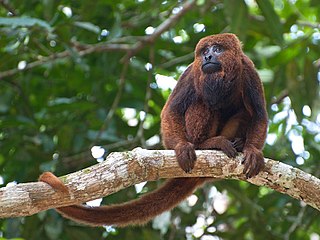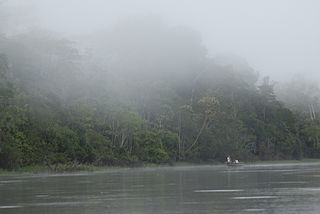
The Purus River is a tributary of the Amazon River in South America. Its drainage basin is 371,042 km2 (143,260 sq mi), and the mean annual discharge is 11,207 m3/s (395,800 cu ft/s). The river shares its name with the Alto Purús National Park and the Purús Province, one of the four provinces of Peru in the Ucayali Region.

The Atelidae are one of the five families of New World monkeys now recognised. It was formerly included in the family Cebidae. Atelids are generally larger monkeys; the family includes the howler, spider, woolly, and woolly spider monkeys. They are found throughout the forested regions of Central and South America, from Mexico to northern Argentina.

The Colombian red howler or Venezuelan red howler is a South American species of howler monkey, a type of New World monkey, found in the western Amazon Basin in Venezuela, Colombia, Ecuador, Peru and Brazil. The population in the Santa Cruz Department in Bolivia was split off as a separate species, the Bolivian red howler, in 1986, and more recently, splitting off the population in northeastern South America and Trinidad as the Guyanan red howler has occurred. All howler monkeys belong to the family Atelidae and the infraorder Platyrrhini.

The brown howler, also known as brown howler monkey, is a species of howler monkey, a type of New World monkey that lives in forests in south-eastern Brazil and far north-eastern Argentina (Misiones). It lives in groups of two to 11 individuals. Despite the name "brown howler", it is notably variable in colour, with some individuals appearing largely reddish-orange or black.

The black howler or black-and-gold howler, is among the largest New World monkeys and a member of the Alouatta genus. The black howler is distributed in areas of South America such as Paraguay, southern Brazil, eastern Bolivia, northern Argentina, and Uruguay. This species is sexually dimorphic, with adult males having entirely black fur and adult females and babies of both sexes having an overall golden colouring; which emphasizes black-and-gold in the name. The IUCN Red List has classed the black howler as Near Threatened as a result of a recent population reduction due to a variety of human-caused factors.

The red-handed howler is a vulnerable species of howler monkey, a type of New World monkey. It is endemic to Brazil, found in the southeastern Amazon and disjunctly in the Atlantic Forest between Rio Grande do Norte and Sergipe.

The Bolivian red howler is a species of howler monkey, a type of New World monkey, endemic to Bolivia. It can be found in rain forests, including riverine and seasonally flooded forests.

The Amazon black howler is a species of howler monkey, a type of New World monkey, endemic to the south-central Amazon in Brazil. Until 2001, most authorities included it as a subspecies of the red-handed howler, though its distinction had already been pointed out much earlier. As suggested by its name, it typically appears entirely black.

The mantled howler is a species of howler monkey, a type of New World monkey, from Central and South America. It is one of the monkey species most often seen and heard in the wild in Central America. It takes its "mantled" name from the long guard hairs on its sides.

The Yucatán black howler, or Guatemalan black howler, is a species of howler monkey, a type of New World monkey, from Central America. It is found in Belize, Guatemala and Mexico, in and near the Yucatán Peninsula. It lives in evergreen, semideciduous and lowland rain forests. It is also known as the baboon in Belize, although it is not closely related to the baboons in Africa.
The Coiba Island howler is a type of howler monkey, a type of New World monkey, endemic to Panama. Although the Coiba Island howler has been recognized as a separate species by a number of authorities since a 1987 study of its fingerprints, mitochondrial DNA testing found it does not differ from mantled howler populations in any significant way. A reason given for treating it as a separate species is that the dermal ridges of its hands and feet differ from those of the mantled howler.

The chestnut-crowned becard is a species of bird in the family Tityridae. It has traditionally been placed in Cotingidae or Tyrannidae, but evidence strongly suggest it is better placed in Tityridae, where it is now placed by the South American Classification Committee.
Serra da Cutia National Park is a national park in the state of Rondônia, Brazil.

The Mexican howler is a subspecies of the mantled howler, A. palliata. This subspecies is found predominantly in forests between south eastern Mexico and north eastern Peru. Typical of its species, the Mexican howler monkey has a prehensile tail, a deep jaw, and a large pharynx which it uses to make characteristically deep and resonating howls. Mantled howler monkeys are known for forming unusually large cohorts averaging 14 members and sometimes extending to 40 members.

Spix's red-handed howler is a species of Howler monkey native to the southeastern Amazon in Brazil. It is threatened by deforestation and hunting.

The southern brown howler is a monkey subspecies of brown howler native to southeastern Brazil and far northeastern Argentina (Misiones). Gregorin, 2006, considered the southern brown howler to be a separate species, Alouatta clamitans, but this has not been universally accepted.

The Purús red howler is a species of howler monkey native to Brazil, Peru and north of Bolivia.

The Iquitos várzea (NT0128) is an ecoregion of flooded forest along rivers in Brazil, Peru and Bolivia in the west of the Amazon biome. The forest is seasonally flooded up to 7 metres (23 ft) by whitewater rivers carrying nutrient-rich sediment from the Andes. The meandering rivers often shift course, creating a complex landscape of oxbow lakes, marshes, levees and bars, with grasslands, shrubs and forests in different stages of succession. During the extended flood periods fish enter the forest in search of fruit. The várzea is accessible by the navigable rivers that run through it, and has suffered from extensive deforestation to extract timber and create pasture for livestock.















